Commodities
Gold retreats ahead of U.S. inflation data release

Gold prices fell on Wednesday after strengthening in the previous two sessions as investors adjusted positions in anticipation of U.S. inflation data for April, which could affect the Federal Reserve’s policy.
The spot gold price fell 0.25% to $2,029.06 a troy ounce. Economists expect core consumer prices to rise 5.5% year-over-year in April.
“Right now, gold in dollar terms has good support up to the $1.970 level, while resistance could occur in a range between $2.066-$2.076,” said Daniela Hathorn of capital.com.
“We may see a rebound in stocks today when the U.S. Consumer Price Index comes out if the data shows that inflation continues to decline. But we will likely continue to see support for buying gold as concerns about economic growth maintain the path of least resistance to upside,” added Hawthorne.
Fed Chairman Jerome Powell said that the question of whether to continue raising rates remains open as the economy continues to face high inflation but shows signs of slowing.
Although gold is considered a hedge against inflation, rising interest rates are making the non-interest-bearing precious metal less attractive.
But analysts say gold could make another attempt to hit record highs given ongoing economic concerns, including worries about the U.S. government debt ceiling.
U.S. President Joe Biden and top U.S. lawmakers agreed Tuesday to continue talks and seek a way out of the impasse over raising the size of the national debt, now capped at $31.4 trillion.
If U.S. inflation remains moderately under control, that could lead to a pause in rate hikes, weakening the dollar and supporting gold, said Harish B, of Geojit Financial Services.
Palladium was steady at $1,569.96 an ounce and silver was down 0.23% to $25.56 an ounce. Platinum was down 0.13% to $1,103.25.
Earlier, we reported that the Gas gets cheaper in Europe amid high supply, good stocks.
Commodities
Oil prices rise; U.S. crude inventories plunge, Russia-Ukraine truce eyed
Commodities
India’s Reliance to stop buying Venezuelan oil over US tariffs, sources say
Commodities
Oil prices climb on Venezuela supply worries

 Forex3 years ago
Forex3 years agoForex Today: the dollar is gaining strength amid gloomy sentiment at the start of the Fed’s week

 Forex3 years ago
Forex3 years agoUnbiased review of Pocket Option broker

 Forex3 years ago
Forex3 years agoDollar to pound sterling exchange rate today: Pound plummeted to its lowest since 1985

 Forex3 years ago
Forex3 years agoHow is the Australian dollar doing today?

 Cryptocurrency3 years ago
Cryptocurrency3 years agoWhat happened in the crypto market – current events today

 World3 years ago
World3 years agoWhy are modern video games an art form?

 Commodities3 years ago
Commodities3 years agoCopper continues to fall in price on expectations of lower demand in China

 Economy3 years ago
Economy3 years agoCrude oil tankers double in price due to EU anti-Russian sanctions























